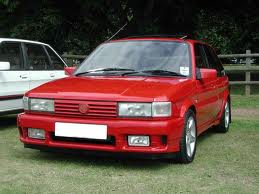


This edition of the Ford Capri 2.8i is the 5 speed / Manual version and was first brought out in 1981. This was at around the same time as the introduction of the 1982 Fiat X1/9 1.5 8V and the 1982 Lamborghini Countach LP500S.This particular Ford Capri has a 2792cc Naturally Aspirated Petrol powerplant with 6 cylinders in a V formation.
The Capri shares its Petrol V6 engine configuration with the likes of the 2014 Radical RXC 3.5 V6 Twin Turbo and the 2015 Radical RXC Turbo 500 3.5 V6. If you're looking for other fast cars which share the Capri's Rear Wheel Drive, Coupe combination then how about the 1982 Fiat X1/9 1.5 8V or the 1965 Aston-Martin DB6 1965.
Weighing in at 1190 kgs (2623 lbs) this makes the Ford Capri 2.8i in the same weight category as the 2018 McLaren Senna 4.0 V8 Twin Turbo or the give or take 50kg.
![Audi A1 A1 Sportback 35 TFSI S tronic S line - [2020] image Audi A1 A1 Sportback 35 TFSI S tronic S line - [2020] image](/editionimages/2015.jpg)
The Ford Capri shares the same bhp with the 2020 Audi A1 A1 Sportback 35 TFSI S tronic S line (148 bhp)
In terms of power the 2792cc 12V V6 engine produces 160 bhp (119 kW) @ 5700 rpm similar to the 2020 Audi A1 A1 Sportback 35 TFSI S tronic S line (148 bhp) or the 2020 Abarth 695 70th Anniversario 1.4 Turbo (177 bhp).
The Naturally Aspirated V6 throws out 162 lb-ft (219.6 Nm) @ 3000 rpm placing it with cars of similar torque performance figures such as the 2022 Mini Cooper Countryman John Cooper Works 1.5 Turbo (162 lb-ft) or the 2020 Audi A1 A1 Sportback 35 TFSI S tronic S line (184 lb-ft).
If one combines the weight with power or torque performance for the Ford Capri you can get a better idea of it's real world performance.
The Ford Capri has a Power to weight ratio of 134.4 bhp per ton and 136.1 lb-ft per ton. Bhp Per Ton figures of the 1981 Capri competing with the 2005 Ford Focus 2.5 ST-2 (159.4 bhp per ton) or the 1991 Lancia Delta HF Integrale 16v (159.2 bhp per ton).
If you agree with the late great Carroll Shelby then arguably an even better indicator of potential performance, Torque. Use weight as well and you end up with - Torque per ton, with the Ford Capri generating around 136.1 lb-ft per ton. If you're curious as to what other cars have as much torque to weight then look no further than the 2012 Volkswagen-VW Golf R 2.0 Turbo (161.1 lb-ft per ton) or the 1994 Toyota Celica GT Four ST205 (161.1 lb-ft per ton).
With a 0-60mph time of 7.90 secs or a 0-100km/h (0-62mph) of 8.2 secs, this made the Ford Capri 2.8i as fast as the 2016 Audi A3 2.0 TDI Quattro (7.90 secs) the 2013 Skoda Octavia RS TDI (7.90 secs) the 2013 Subaru BRZ 2L 210ps Sportshift (7.90 secs) the or the 2011 Infiniti FX 30d 3.0 V6 Diesel (7.90 secs). This Ford Capri 2.8i is also faster than the 2011 Citroen DS5 1.6 THP 200 (8.00 secs) the 2009 Porsche Cayenne 3.0 V6 Turbo Diesel (8.00 secs) the 2008 Alfa-Romeo Mito 1.4 155 T-Jet Veloce (8.00 secs) the and the 2007 Fiat Bravo 1.9 Sport Multijet (8.00 secs).
When talking about the performance of the Ford Capri on the drag strip it can reach a quarter mile in an estimated 16.02 secs @ 85.4 mph. Similar performance down the quarter mile can be found with the the 2002 Volkswagen-VW Golf R32 (15.94 secs), the 2001 Mercedes CLK 430 4.3 V8 (15.94 secs), and the 1980 Porsche 911 SC (15.95 secs).
Modern performance cars are often artificially restricted to 155mph. The 1981 version of the Ford Capri 2.8i has a maximum speed of 129mph.
If maxing out your car on the AutoBahn is your thing and you're wondering what's faster than the 1981 Ford Capri 2.8i then how about the 2021 BMW i4 M50 (140 mph), the 2020 Abarth 695 70th Anniversario 1.4 Turbo (140 mph), or the 2019 Tesla Model 3 Standard Range Plus (140 mph).










Pontiac GTO 6.0 V8
Engine: Naturally Aspirated Petrol | 5970cc 16v V8
Top Speed: 180 mph
0-60mph: 5.00 seconds

Volkswagen-VW Touareg 4.2 V8 FSI
Engine: Naturally Aspirated Petrol | 4163cc 32v V8
Top Speed: 233.3 kph
0-100kph: 7.4 seconds



















